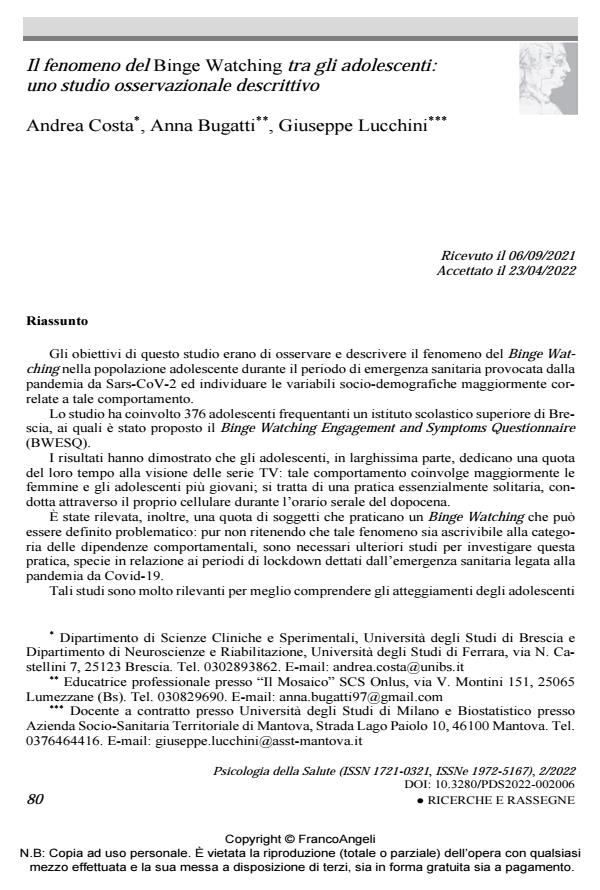Il fenomeno del Binge Watching tra gli adolescenti: uno studio osservazionale descrittivo
Titolo Rivista PSICOLOGIA DELLA SALUTE
Autori/Curatori Andrea Costa, Anna Bugatti, Giuseppe Lucchini
Anno di pubblicazione 2022 Fascicolo 2022/2
Lingua Italiano Numero pagine 29 P. 80-108 Dimensione file 381 KB
DOI 10.3280/PDS2022-002006
Il DOI è il codice a barre della proprietà intellettuale: per saperne di più
clicca qui
Qui sotto puoi vedere in anteprima la prima pagina di questo articolo.
Se questo articolo ti interessa, lo puoi acquistare (e scaricare in formato pdf) seguendo le facili indicazioni per acquistare il download credit. Acquista Download Credits per scaricare questo Articolo in formato PDF

FrancoAngeli è membro della Publishers International Linking Association, Inc (PILA)associazione indipendente e non profit per facilitare (attraverso i servizi tecnologici implementati da CrossRef.org) l’accesso degli studiosi ai contenuti digitali nelle pubblicazioni professionali e scientifiche
Gli obiettivi di questo studio erano di osservare e descrivere il fenomeno del Binge Wat-ching nella popolazione adolescente durante il periodo di emergenza sanitaria provocata dalla pandemia da Sars-CoV-2 ed individuare le variabili socio-demografiche maggiormente corre-late a tale comportamento. Lo studio ha coinvolto 376 adolescenti frequentanti un istituto scolastico superiore di Brescia, ai quali è stato proposto il Binge Watching Engagement and Symptoms Questionnaire (BWESQ). I risultati hanno dimostrato che gli adolescenti, in larghissima parte, dedicano una quota del loro tempo alla visione delle serie TV: tale comportamento coinvolge maggiormente le femmine e gli adolescenti più giovani; si tratta di una pratica essenzialmente solitaria, condotta attraverso il proprio cellulare durante l’orario serale del dopocena. È state rilevata, inoltre, una quota di soggetti che praticano un Binge Watching che può es-sere definito problematico: pur non ritenendo che tale fenomeno sia ascrivibile alla categoria delle dipendenze comportamentali, sono necessari ulteriori studi per investigare questa pratica, specie in relazione ai periodi di lockdown dettati dall’emergenza sanitaria legata alla pandemia da Covid-19. Tali studi sono molto rilevanti per meglio comprendere gli atteggiamenti degli adolescenti nei confronti dei media digitali - in particolare delle serie TV - al fine di promuovere efficaci piani di educazione che ne limitino i comportamenti d’abuso.
Parole chiave:adolescenti, Binge Watching, serie TV, dipendenze comportamentali.
Andrea Costa, Anna Bugatti, Giuseppe Lucchini, Il fenomeno del Binge Watching tra gli adolescenti: uno studio osservazionale descrittivo in "PSICOLOGIA DELLA SALUTE" 2/2022, pp 80-108, DOI: 10.3280/PDS2022-002006